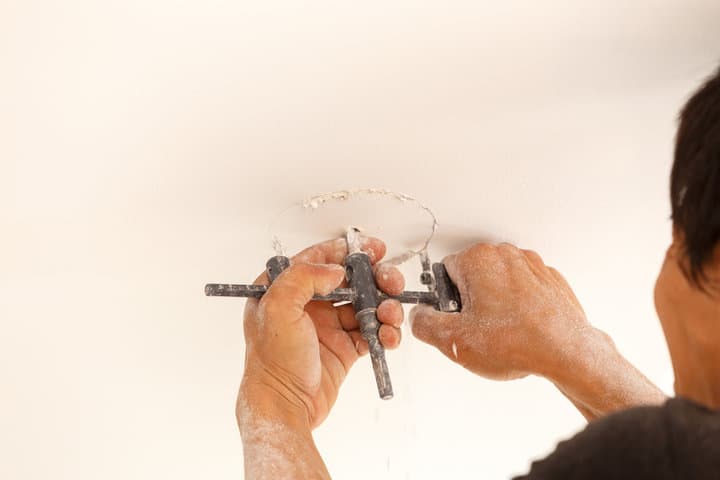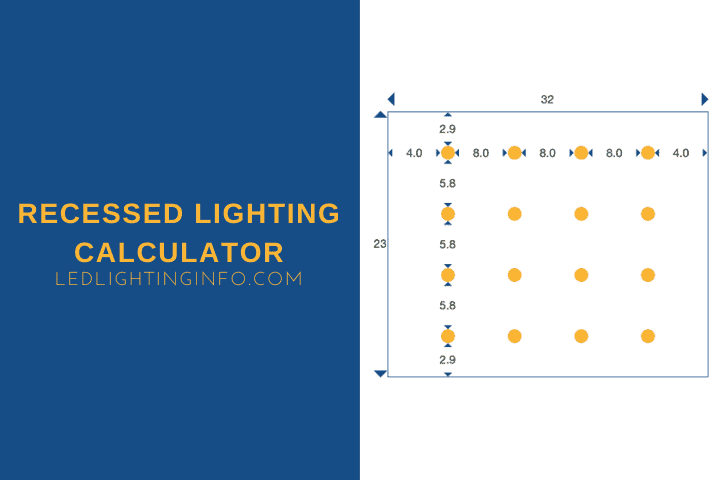Looking to install recessed lights in your home? It’s really important you spend some time working out exactly where the lights are going to go.
If you don’t put any thought into how many lights you need, or your recessed lighting layout, you’re going to end up with a room that’s unevenly lit, and that looks slopping.
Trust me, you might not think that the spacing between lights will be noticeable, but it really is. Every time you enter a room you’ll just be able to see the inaccurate measurements, and it’ll really annoy you.
But, working out the lighting plan can be tricky if you’re not the best with numbers, or you’re just short on time. Which is why I’ve created this recessed light calculator, to just make it super-easy for you.
The Purpose of a Recessed Lighting Calculator
Calculator is a tool you can use to work out the spacing formula for your recessed lighting installation.
It will tell you everything you need to know about where to place your recessed lights, so that you get even coverage around the room.
Once you’ve used the calculator, you can then get to work on installing the light fixtures in the right place, with the correct distance between them.
No complicated math for you – just measure the dimensions of the space, and you’re ready to start.
How to Use this Calculator
My calculator is really simple to use. I’ve stripped back some of the detail about lumen output and types of lights – I’ll explain why shortly.
1. Input The Room Dimensions
The first thing you need to do is input the room dimensions – the length and the width of the space. I’ve purposely didn’t mark these in the calculator because it works with any measures that you are used to. Feet, meters or millimeters the calculator will still work the same – so feel free to use whatever measurement you prefer.
2. Add the Columns and Rows
Next up, choose the number of rows and columns of lights that you’re going to use.
You might not know this yet – and that’s OK. Use the calculator to test out some different layouts.
It’d be better to have similar distances between the lights in all directions, so if you have a square room, don’t use two columns and four rows – the columns will be much further apart, and it won’t be balanced.
3. Hit ‘Calculate’
Once you’re happy with the measurements and the rows/columns, hit the calculate button. It’ll then determine the spacing between each light.
If it doesn’t seem right, try changing the row and column numbers. Once you’re happy, make a note of all the measurements.
4. Measure & Mark On Your Ceiling
Using the measurements from the calculator, mark on your ceiling where you’re going to install each light. Start with the first light, and measure from the wall.
Then, measure the rest of that row, before starting with the next one.
Be careful – depending on your ceiling height, you may need to use a stepladder to do this effectively. And you need to be accurate.
It’s best to measure twice. Space out the lights as designed, measuring from one corner. And then check that the last lights you mark have the correct spacing from the other corner.
Limitations Of A Light Spacing Calculator

When using a recessed lighting calculator, it’s important to keep in mind that it is just a tool to help you determine the number and placement of your lights.
Here are some of the limitations of a calculator, or the mistakes you may make yourself if you’re not careful:
1. Not considering the function of the room
A light spacing calculator can’t account for how you use the room. Living rooms will probably want a different number of lights than somewhere that needs task lighting, such as a kitchen. You want the illumination level to be a little more relaxed in a space where you’re going to unwind.
This is something you’ll need to consider yourself, before deciding how many lights you want to add.
2. Discounting the height of the ceiling
The height of your ceiling is an important factor to consider when using a light spacing calculator. If your ceiling is too high, you may need more powerful lights to properly illuminate the room.
On the other hand, if your ceiling is too low, you may need to use shallower fixtures to avoid creating a glare, or you might want to space out each fixture more to get the same effect.
3. Not accounting for natural light
Don’t forget to take into account any natural light sources in the room, such as windows or skylights. If the room already receives a lot of natural light, you may not need as many recessed lights.
4. Overcrowding the ceiling with too many lights
While it may be tempting to add as many lights as possible, overcrowding the ceiling with too much recessed lighting can actually have the opposite effect and make the room feel cluttered.
Make sure to follow the recommended spacing guidelines provided by the calculator. Even with larger rooms, you don’t want to flood the space too much.
5. Not considering the color temperature of the lights
The color temperature of your recessed lighting can have a big impact on the overall feel of the room. Make sure to choose a color temperature that complements the room’s decor and creates the desired atmosphere.
6. Not accounting for furniture and fixtures
A lot of people choose to use recessed lighting in the kitchen. If you do, you may have cabinets installed along one wall.
Make sure you take these into account when you plan your lighting. You don’t want your general lighting to be partially covered by the top of a cabinet, after all!
Start your measurements from the cabinet doors, if they’re mounted at eye level, rather than from the edge of the wall. This will ensure you get the proper coverage of the floor from your recessed lighting.
Think of your cabinet doors as essentially being a false wall, and start from there.
Of course, if the cabinets only run along part of a wall, you may need to think about spacing a column unevenly instead.
7. No option for custom lighting styles
My calculator is perfect for most rooms where you just want the general lighting to offer an even brightness across the space.
But say you want a focal point using wall washing, or you want to focus the lights on certain areas of the room where you carry out certain tasks.
You can use my calculator still, to get a feel for the spacing. But then you may need to make some customizations to the plans yourself.
Final word
I’ve made sure my calculator is really easy to use. It’s simple formula can take some of the thinking out of your project, so you can just get on with the challenge of wiring up your recessed lighting and making sure it works correctly.
Why not check out some of my other guides on the subject?
- How To Run Wire For Recessed Lighting?
- How Many Recessed Lights Do I Need?
- How To Space Recessed Lighting In Kitchen?
Looking for an LED bulb but not sure what type you need?
Check out my free bulb picker and select the right bulb within few clicks.


